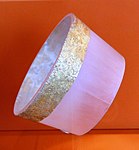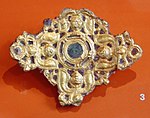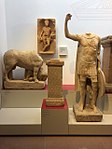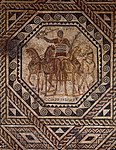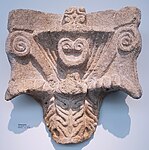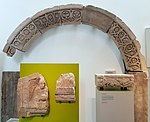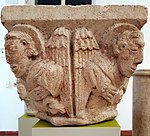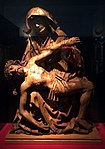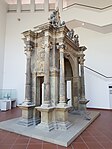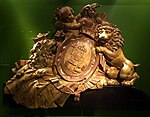
Trier, formerly known in English as Treves and Triers, is a city on the banks of the Moselle in Germany. It lies in a valley between low vine-covered hills of red sandstone in the west of the state of Rhineland-Palatinate, near the border with Luxembourg and within the important Moselle wine region.

The shipwreck of Mahdia was found by Greek sponge fishermen off the coast of Tunisia in June 1907. The shipwreck near the modern town of Mahdia is dated about the 80s BC, or even later.
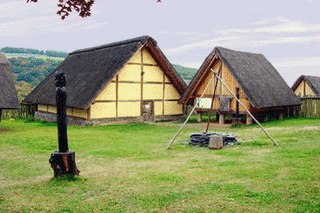
The Treveri or Treviri were a Celtic tribe of the Belgae group who inhabited the lower valley of the Moselle from around 150 BCE, if not earlier, until their displacement by the Franks. Their domain lay within the southern fringes of the Silva Arduenna, a part of the vast Silva Carbonaria, in what are now Luxembourg, southeastern Belgium and western Germany; its centre was the city of Trier, to which the Treveri give their name. Celtic in language, according to Tacitus they claimed Germanic descent. They possibly contained both Gallic and Germanic influences.
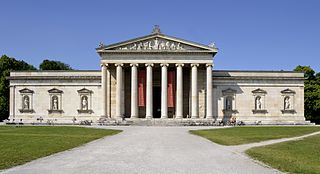
The Glyptothek is a museum in Munich, Germany, which was commissioned by the Bavarian King Ludwig I to house his collection of Greek and Roman sculptures. It was designed by Leo von Klenze in the neoclassical style, and built from 1816 to 1830. Today the museum is a part of the Kunstareal.

The Capitoline Museums is a single museum containing a group of art and archaeological museums in Piazza del Campidoglio, on top of the Capitoline Hill in Rome, Italy. The historic seats of the museums are Palazzo dei Conservatori and Palazzo Nuovo, facing on the central trapezoidal piazza in a plan conceived by Michelangelo in 1536 and executed over a period of more than 400 years. The history of the museum can be traced to 1471, when Pope Sixtus IV donated a collection of important ancient bronzes to the people of Rome and located them on the Capitoline Hill. Since then, the museums' collection has grown to include many ancient Roman statues, inscriptions, and other artifacts; a collection of medieval and Renaissance art; and collections of jewels, coins, and other items. The museums are owned and operated by the municipality of Rome.

Neumagen-Dhron is an Ortsgemeinde – a municipality belonging to a Verbandsgemeinde, a kind of collective municipality – in the Bernkastel-Wittlich district in Rhineland-Palatinate, Germany. It is a state-recognized tourism community, and it was the seat of the former Verbandsgemeinde of Neumagen-Dhron. Its situation and amenities make it a lower-order centre.

Gamzigrad is an archaeological site, spa resort and UNESCO World Heritage Site of Serbia, located south of the Danube river, in the city of Zaječar. It is the location of the ancient Roman complex of palaces and temples Felix Romuliana, built by Emperor Galerius in Dacia Ripensis. The main area covers 10 acres (40,000 m2).

The Madaba Map, also known as the Madaba Mosaic Map, is part of a floor mosaic in the early Byzantine church of Saint George in Madaba, Jordan. The Madaba Map is of the Middle East, and part of it contains the oldest surviving original cartographic depiction of the Holy Land and especially, Jerusalem. It dates to the sixth century AD.

The Hatay Archaeology Museum is the archaeology museum of Antakya, Turkey. It is known for its extensive collection of Roman and Byzantine Era mosaics. The museum is located in Antakya, the main city of Hatay. Construction of the museum started in 1934 on the recommendation of the French archaeologist and antiquities inspector Claude M. Prost. It was completed in 1938 and came under Turkish control in 1939 following Hatay's unification with Turkey. The museum was opened to the public in 1948 and re-opened in 1975 following renovation and expansion.
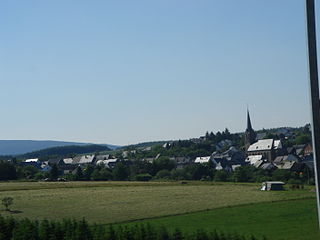
Bundenbach is an Ortsgemeinde – a municipality belonging to a Verbandsgemeinde, a kind of collective municipality – in the Birkenfeld district in Rhineland-Palatinate, Germany. It belongs to the Verbandsgemeinde Herrstein-Rhaunen, whose seat is in Herrstein.

Lugdunum, formerly known as the Gallo-Roman Museum of Lyon-Fourvière, is a museum of Gallo-Roman civilisation in Lyon. Previously presented at the Museum of Fine Arts of Lyon and the Antiquarium, the municipal Gallo-Roman collection was transferred to a new building designed by Bernard Zehrfuss and opened in 1975 near the city's Roman theatre and odeon, on a hill known as Fourvière, located in the heart of the Roman city. Internally, it is formed of a concrete spiral ramp descending and branching out into the display rooms. It is managed and operated by the Metropolis of Lyon jointly with the archaeological museum of Saint-Romain-en-Gal. As well as displaying its own permanent collections of Roman, Celtic and pre-Roman material, a plan-relief of the ancient town and scale models of its major monuments such as the theatre and the Odeon, it also regularly hosts temporary exhibitions.
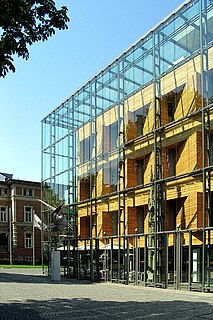
The Rheinisches Landesmuseum Bonn, or LVR-LandesMuseum Bonn, is a museum in Bonn, Germany, run by the Rhineland Landscape Association. It is one of the oldest museums in the country. In 2003 it completed an extensive renovation. The museum has a number of notable ancient busts and figures dating back to Roman times.
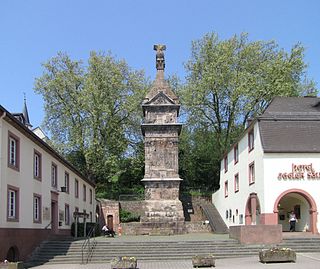
The Igel Column is a multi-storeyed Roman sandstone column in the municipality of Igel, Trier, Germany, dated to c. 250 AD. The column is the burial monument of the Secundinii cloth merchant family.

The Roman Monuments, Cathedral of St. Peter and Church of Our Lady in Trier are heritage sites of particular importance in Trier, Germany, that were together listed as a UNESCO World Heritage site (WHS) in 1986.

The Trier Gold Hoard is a hoard of 2516 gold coins with a weight of 18.5 kg found in Trier, Germany, in September 1993 during construction works. It is described as the largest preserved Roman gold hoard worldwide. The hoard is on exhibition at the Rheinisches Landesmuseum Trier.

Ehrang station is, after Trier Hauptbahnhof, the second most important station in the city of Trier in the German state of Rhineland-Palatinate. The station forms a railway junction with a former marshalling yard, which is still partly used as a freight yard. At the station, the Eifel Railway from Cologne connects with the Koblenz–Trier railway. Until 1983, Ehrang station was also the starting point of the Trier West Railway to Igel, which connected with Wasserbillig / Luxembourg.

Elvira Louiza Helene Fölzer was a German classical archaeologist. With a thesis on Ancient Greek vases, she was the first woman to earn a doctorate at the University of Bonn. As a researcher at the Provincial Museum in Trier, she went on to investigate the origins of the city's terra sigillata Roman pottery.

Gisela Hellenkemper Salies was a German classical archaeologist and museum curator.

The Assyrian Timber Transportation relief is a well-known wall relief from the palace of Dur-Sharrukin, the Assyrian capital under Sargon II. The reliefs are held in the Louvre, having been excavated in 1844 by Paul-Émile Botta.





